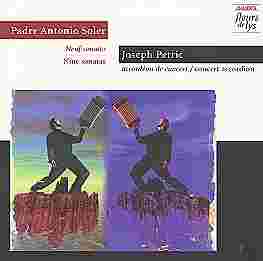 Joseph Petric, accordion
Joseph Petric, accordion Program:
Sonata in D Major Allegro con Ayre
Sonata in G Major Andante gracioso, Allegro non troppo
Sonata in E Minor Minuet I, Maestoso, Minuet II, Allegro molto da capo
Sonata in G Major Allegro
Sonata in D Minor Allegro
Sonata in F Major Andante cantabile
Sonata in Bb Major Allegretto espressivo, Allegro spiritoso
total time: 54:22
Released in 1999
Review date: March 2000
Label: Analekta, Inc.
364, rue Guy #G15
Montr al, Qu bec H3J 1S6
Canada
Phone: +1/514 939-0559 - (sans frais/toll-free) 1-888-939-0559
Fax: +1/514 939-0232
Email: analekta@qc.aira.com
Review by Henry Doktorski:
Regular visitors to The Classical Free-Reed, Inc. website are probably already familiar with Canadian concert accordionist Joseph Petric; he was featured on six separate compact disc reviews which appeared in the pages of The Free-Reed Review. And every single one of them, I might add, is a credit to the classical accordion community. This new CD, featuring nine sonatas of the Baroque Spanish composer Padre Antonio Soler y Ramos (1729-1783), is no exception. Soler, a student of Domenico Scarlatti, was renowned across Europe by the age of 20. He was ordained sub-deacon of the Jeronymite order of monks at the monastery of El Escorial in 1752 and remained there for most of his life.Although Soler wrote 9 masses, 5 requiems, 5 motets, 16 responsories, 28 lamentations, 25 hymns, 60 psalms, 13 Magnificat, 12 Benedicamus, 132 villancicos, he is best-known for his 120 keyboard sonatas. Mr. Petric chose to record nine of Soler's sonatas on this CD. I should mention that this is not Petric's first recording of Soler; he included the Allegro spiritoso from the Bb sonata in an earlier recording, Joseph Petric, Accordion.
I won't go into detail about each sonata, but I will tell you that Petric plays them all with authority and confidence. His technique is faultless and his musicianship is well seasoned (although I was startled by a rather curious and uncharacteristically odd tremolo at the end of the Andante gracioso in the G Major sonata). In my opinion, Soler's music seems to flow from Petric's instrument like a fragrance flows from a garden of blooming roses; effortlessly.
Perhaps I might mention that one of my more knowledgeable friends was disturbed by Petric's non-Baroque fluctuations of tempo, but I found his pliable phrases quite enjoyable and, I believe, not stylistically incorrect. Interpretation is a personal matter, despite the claims of members of the "authentic historic performance" movement. One of my favorite recordings of the monumental Bach B Minor Mass is a gooey version with Herbert von Karajan conducting the souped-up Berlin Philharmonic with a chorus of hundreds. The last chord of the concluding Amen seems to go on forever; it must last ten seconds! But it is a powerful and moving interpretation; certainly more moving to me than the "authentic" performances with a small chamber orchestra and twenty singers. I believe Petric is a mature performer and his liberties are both subtle and within good taste. Personally, I think the pieces would be dull without some flexibility in tempo.
It is a simple matter to record an album of unrelated pieces; it is an entirely different matter to record an album of works by a single composer, and Petric deserves our utmost respect for this endeavor. I have always admired performers who can play an entire recital of works by one composer. I treasure my autographed thirteen-LP boxed set of the 32 Beethoven piano sonatas by Claudio Arrau, whom I met in 1977 while a piano major at Park College in Kansas City, Missouri. My seventeen CD set of the complete Bach organ works by Hans Fagius is also appreciated in the same way. And I predict that Joseph Petric's CD of Soler's sonatas will be similarly treasured by classical free-reed aficionados.
Oh yes, I should mention that Petric plays a first-row chromatic C system right-hand, left-hand nine-row combination stradella with three-row chromatic free-bass (bassetti), designed by Joseph Petric and engineered, built and tuned by Leo Niemi. I happened to be in Canada visiting Leo (who worked on my own instrument) when he was building Petric's accordion. Petric's instrument is a magnificent hybrid. If memory serves me correctly, the right-hand mechanism is from a Hohner Gola and the left-hand mechanism is from another instrument. There are some special features of Petric's accordion, such as newly patented reed blocks, reed chambers, sound posts, sound holes, resonating chambers, silicone treatment and wood combinations. The reeds were cut from Swedish blue steel and tuned at A 440. By the way, this accordion is NOT the instrument which appears in the CD cover photo.
CD booklet notes are written by Joseph Petric and appear in English and French.
| About The Free-Reed Review |
| Invitation to Contributors / Submission Guidelines |
| Back to The Free-Reed ReviewContents Page |
| Back to The Classical Free-Reed, Inc. Homepage |